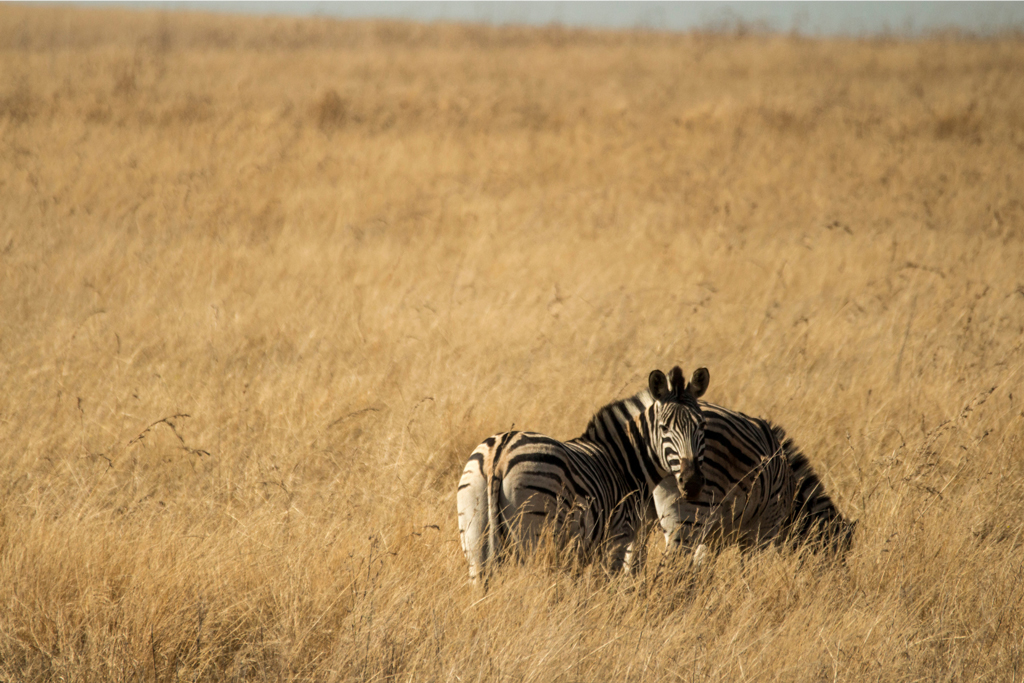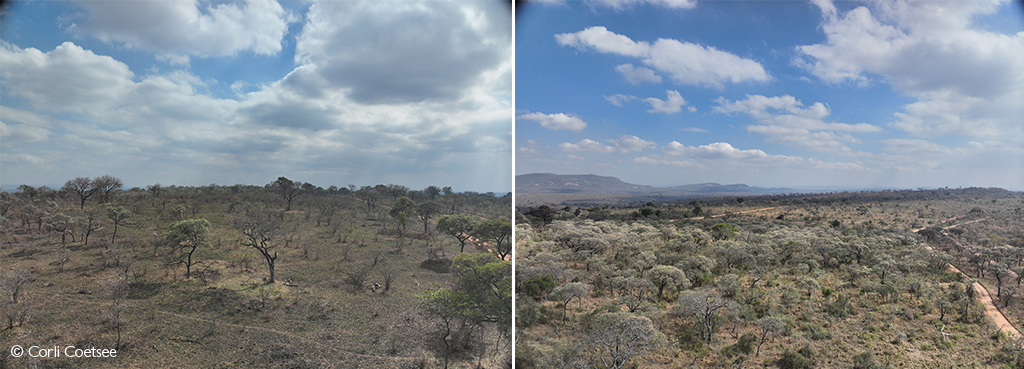
When we picture efforts to combat climate change, trees often steal the spotlight. But what if the real climate heroes are right under our noses – or rather, under our feet? Enter grasslands, the overlooked powerhouses of carbon sequestration. Research reveals that these sprawling landscapes store carbon far more efficiently than trees, challenging the widespread belief that forests are always the best option for restoration. Should we be better prioitising the conservation of grasslands?
“They kind of look like caterpillars in the landscape,” says SANParks ecologist Corli Coetsee, describing the research plots near the Pretoriuskop Rest Camp in the southwest of Kruger National Park, South Africa.
These plots, each around 7 hectares (17 acres), are surrounded by firebreaks and are strung together so that, when viewed via satellite, they resemble giant segmented worms wriggling across the savannah. These plots are used to explore the effects of fire on the ecosystem. Some plots are burned annually, others every two to three years, and some during different seasons. One plot in each “string,” as the researchers call them, has not been burned in 70 years. The unburned plots and those burned during cooler conditions are increasingly encroached by trees.

Coetsee recently published a study in the Journal of Ecology that reveals a surprising finding: although the trees on these unburned plots do contribute to stored soil carbon, it has taken them 70 years to achieve the same levels as the grassy plots.
“What we showed is that it takes a very long time for tree-derived soil carbon to start equalling the soil carbon contributed by grasses,” she explains.

This research highlights a critical yet often overlooked fact: undisturbed grasslands are vital in combating global heating. They sequester carbon not in towering trees, but in the roots of grasses and herbaceous plants known as forbs, which lock carbon within the topsoil.
Despite this, grasslands are frequently seen as empty spaces ripe for tree planting to meet global reforestation targets. However, not all spaces are suitable for forests. Earlier this year, University of Oxford ecologist Nicola Stevens and her colleagues published an article in Science warning that, of the more than 133 million hectares (328 million acres) planned for forest restoration in 35 countries under the African Forest Landscape Restoration Initiative (AFR100), 70.1 million hectares (more than 173 million acres) are located in ecosystems that are not naturally forested – primarily lightly wooded savannahs and pure grasslands.

“This is greater than the area of France, indicating that tree-based restoration in Africa could cover vast areas of non-forest habitat,” they cautioned.
Coetsee echoes this concern. “People should be much more reluctant to plant trees in systems that are supposed to be open,” she argues. “These grassland systems are ancient; they evolved to be open, with sun-loving vegetation that effectively stores carbon underground where it’s safe from fires.”
The complexity and value of grasslands are often misunderstood. Many grassland plant species are long-lived but reproduce infrequently and are poor colonisers, says Susanne Vetter, an ecologist at Rhodes University. “Once you’ve destroyed grassland biodiversity, for example, through ploughing, planting trees, or similar actions, it’s really hard to get it back,” Vetter warns.
Fire plays an essential role in maintaining this biodiversity while also contributing to the accumulation of soil carbon, adds Vetter, describing how the roots of grasses and forbs die back after each burning, adding organic matter to the topsoil and increasing carbon storage. Charcoal fragments from fires also contribute to stable forms of carbon within the soil.

“Grasslands that are healthy keep incorporating more carbon,” she says. Fire also prevents the encroachment of woody plants—a growing threat as atmospheric CO2 levels rise.
Researchers like Coetsee refer to the latter as “CO2 fertilisation,” which accelerates the growth of native trees, turning them into “super trees” with larger roots and faster growth rates. This shift has tangible effects on wildlife. In Kruger National Park, for example, the expansion of trees is visibly impacting some animal populations.
“We’ve seen large changes in Kruger; some of the rare antelope like sable (Hippotragus niger) and reedbuck (Redunca arundinum) have seen their numbers decrease hugely,” Coetsee notes. “My gut feeling is that it has something to do with this shift from grassy landscapes to more closed, tree-dominated landscapes.”

The impact extends beyond mammals. Chevonne Reynolds, an associate professor in the School of Animal, Plant, and Environmental Sciences at Wits University, has studied the effects of woody plant encroachment on common bird species in grassy ecosystems in South Africa, Eswatini, and Lesotho. She and colleagues, who recently published their findings in Global Change Biology, discovered that nearly 20% of the 191 species surveyed experienced population declines over 10 years.
Among the most affected were birds – vividly-coloured Orange River francolin (Scleroptila levaillantoides), and the tawny eagle (Aquila rapax), which is already listed as Vulnerable by the International Union for Conservation of Nature.
Reynolds and her colleagues predict that tawny eagle populations could decline by a further 50% within the next 20 years due to the loss of suitable habitat.

Since 2016, Reynolds has returned regularly to Eswatini’s eastern lowveld region, near the Lebombo Mountains, to measure bird diversity. While carrying equipment through the bush to do fieldwork was difficult back then, it’s now nearly impossible due to the increase in thick, woody vegetation.
“Just seeing the shift in the amount of woody biomass that now exists in those landscapes is really striking,” she says.
The 2018 National Biodiversity Assessment found that only 59% of South Africa’s grasslands now remain, but the condition of these surviving areas is unclear. In addition to being undervalued as carbon stores, most grasslands lie outside protected areas, making them vulnerable to conversion for agriculture and other land uses. Some conservation groups are working to change this.
Damian Walters, the Endangered Wildlife Trust’s regional manager for the African Crane Conservation Programme, works with landowners in the eastern Free State and other regions of South Africa to protect grasslands on their farms.

These areas are vital not only for biodiversity, supporting species like South Africa’s three crane species, the wattled (Grus carunculata), blue (G. paradise), and grey-crowned (Balearica regulorum) cranes, but also for carbon sequestration.
Under South Africa’s national biodiversity stewardship programme, the Endangered Wildlife Trust has helped incorporate around 130,000 hectares (321,000 acres) of grasslands into the protected areas network. The organisation is also partnering with other conservation groups and landowners to develop carbon offset projects that leverage the carbon stored in grassland soils.
“In our grasslands, we don’t focus on above-ground carbon storage; our grasslands often burn, and they’re supposed to,” Walters explains. “So, we’re really focusing on the below-ground carbon stocks and seeing if we can enhance the amount of carbon stored in the soils through improved management, and then rewarding the landowner for that additional carbon in a way that aligns with the best ecological management of those systems.”

The benefits of this approach are manifold.
“You’ve got livestock grazing, carbon being sequestered, and water catchments being secured,” says Walters. “It’s a way of funding [grassland conservation] work that would never happen without it.”
Grasslands may not have the towering presence of forests, but their impact on our planet is just as profound. As the world rushes to plant trees, we must not overlook the grasslands that have been storing carbon and maintaining biodiversity for millennia. By recognising and preserving these vital ecosystems, we can better protect our planet and ensure a balanced approach to conservation. It’s time to shift our focus from what’s above ground to what lies beneath.
Further reading
A recent study on population growth, resource exploitation & climate change highlights the necessary steps for preventing loss of wild habitats & species in Africa. Read our story on safeguarding Africa’s wildlife into the 22nd century.
References
Coetsee, C., February, E. C., Wigley, B. J., Kleyn, L., Strydom, T., Hedin, L. O., … & Pellegrini, A. (2023). Soil organic carbon is buffered by grass inputs regardless of woody cover or fire frequency in an African savanna. Journal of Ecology, 111(11), 2483-2495.
Parr, C. L., Te Beest, M., & Stevens, N. (2024). Conflation of reforestation with restoration is widespread. Science, 383(6684), 698-701.
White, J. D., Stevens, N., Fisher, J. T., & Reynolds, C. (2024). Woody plant encroachment drives population declines in 20% of common open ecosystem bird species. Global Change Biology, 30(6), e17340.
To comment on this story: Login (or sign up) to our app here - it's a troll-free safe place 🙂.![]()






